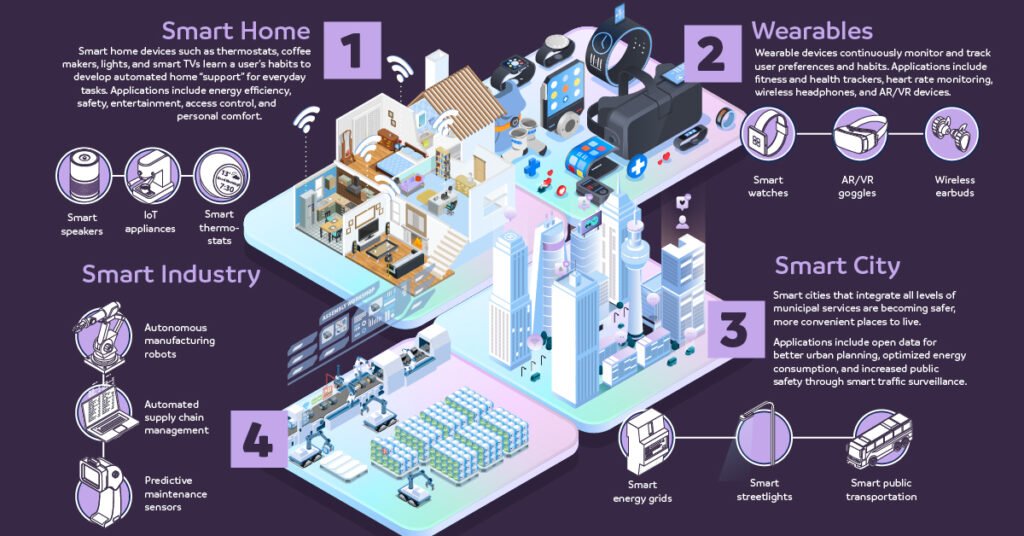
The Power of AIoT: Where Artificial Intelligence Meets the Internet of Things
The world of technology is constantly evolving, and with each passing day, we witness groundbreaking innovations that shape the way we live and work. One such innovation that is revolutionizing various industries is the convergence of Artificial Intelligence (AI) and the Internet of Things (IoT), known as AIoT. This powerful combination has the potential to transform the way we interact with our environment, making our lives more efficient, convenient, and connected.
Understanding AIoT
Before we delve into the power of AIoT, let’s first understand what it entails. AIoT refers to the integration of AI technologies with IoT devices, allowing them to communicate, analyze data, and make intelligent decisions without human intervention. By combining the capabilities of AI and IoT, AIoT enables devices to gather and process vast amounts of data, learn from it, and take actions based on the insights derived.
AIoT brings together the strengths of both AI and IoT. While IoT devices collect and transmit data, AI algorithms analyze this data to identify patterns, make predictions, and automate processes. This synergy opens up a world of possibilities across various sectors, including healthcare, transportation, manufacturing, agriculture, and smart cities.

The Impact of AIoT in Healthcare
One of the areas where AIoT is making significant strides is healthcare. With the integration of AI and IoT, healthcare providers can offer personalized and efficient patient care, leading to better health outcomes. AIoT-enabled devices can continuously monitor patients’ vital signs, detect anomalies, and alert healthcare professionals in real-time, enabling early intervention and reducing the risk of complications.
Moreover, AIoT can enhance the diagnosis and treatment of diseases. By analyzing a vast amount of patient data, AI algorithms can identify patterns and predict the likelihood of certain conditions. This can help doctors make more accurate diagnoses and develop personalized treatment plans. Additionally, AIoT can enable remote patient monitoring, allowing healthcare providers to monitor patients’ health from a distance and provide timely interventions when necessary.
Transforming Transportation with AIoT
AIoT is also reshaping the transportation industry, making it safer, more efficient, and sustainable. By leveraging AIoT technologies, vehicles can become smarter and more autonomous, reducing the risk of accidents and improving traffic flow. AI algorithms can analyze data from various sensors, such as cameras, radars, and LiDAR, to detect obstacles, predict potential collisions, and optimize routes.
Furthermore, AIoT can enable connected vehicles to communicate with each other and with infrastructure, creating an intelligent transportation system. This system can provide real-time information about road conditions, traffic congestion, and weather, helping drivers make informed decisions and avoid delays. Additionally, AIoT can optimize logistics operations, improving the efficiency of supply chains and reducing fuel consumption.
Revolutionizing Manufacturing with AIoT
In the manufacturing sector, AIoT is revolutionizing production processes, making them more efficient, flexible, and cost-effective. By connecting machines, sensors, and AI algorithms, manufacturers can achieve real-time monitoring and predictive maintenance. AIoT-enabled systems can detect anomalies, predict equipment failures, and schedule maintenance activities, reducing downtime and optimizing productivity.
Moreover, AIoT can enhance quality control in manufacturing. AI algorithms can analyze data from sensors and cameras to identify defects, deviations, and potential issues in the production line. This enables manufacturers to take corrective actions promptly, ensuring high-quality products and reducing waste.
AIoT in Agriculture: Cultivating a Smart Future
The agriculture industry is also embracing AIoT to address the challenges of food production, resource optimization, and sustainability. By combining AI algorithms with IoT sensors, farmers can monitor and manage crops more efficiently. AIoT-enabled systems can analyze environmental data, such as temperature, humidity, and soil moisture, to optimize irrigation schedules, detect diseases, and predict crop yields.
Furthermore, AIoT can enable precision agriculture, where farmers can apply fertilizers, pesticides, and water precisely where and when they are needed. This not only reduces resource wastage but also minimizes the environmental impact of agricultural practices. AIoT can also facilitate livestock management by monitoring animals’ health, tracking their location, and providing real-time insights for better decision-making.
Building Smart Cities with AIoT
AIoT plays a crucial role in the development of smart cities, where technology is harnessed to improve the quality of life for residents. By integrating AI and IoT, cities can become more efficient, sustainable, and livable. AIoT-enabled systems can optimize the use of resources, manage energy consumption, and reduce environmental impact.
Moreover, AIoT can enhance public safety and security. By analyzing data from video surveillance cameras, sensors, and social media, AI algorithms can detect and respond to potential threats in real-time. This enables authorities to take proactive measures and ensure the safety of residents.
The Future of AIoT
As AI and IoT continue to advance, the potential of AIoT is boundless. Its applications are not limited to the sectors mentioned above but extend to various domains, including retail, energy, finance, and entertainment. With the increasing availability of data, advancements in AI algorithms, and the proliferation of connected devices, AIoT will continue to shape our future.
However, along with its immense potential, AIoT also raises concerns regarding data privacy, security, and ethical implications. As AIoT becomes more pervasive, it is crucial to establish robust frameworks and regulations to protect individuals’ privacy and ensure the responsible use of AIoT technologies.
Conclusion
The convergence of Artificial Intelligence and the Internet of Things is unlocking a new era of innovation and connectivity. AIoT has the power to transform industries, improve lives, and create a more sustainable future. By harnessing the capabilities of AI and IoT, we can unlock the full potential of data, make intelligent decisions, and build a smarter, more efficient world.
Ready to get started?
Unlock opportunities: Contact Us, Partner with Us and boost your revenue.